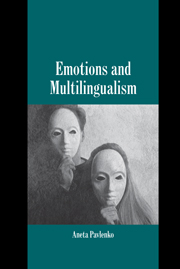Book contents
- Frontmatter
- Contents
- List of Tables
- Preface
- 1 Languages and emotions: What can a multilingual perspective contribute?
- 2 Emotions in the study of multilingualism: Framing the questions
- 3 Vocal level: Is the lady angry?
- 4 Semantic and conceptual levels: The bilingual mental lexicon
- 5 Discursive level: I feel zhalko tebia bednogo
- 6 Neurophysiological level: His coeur is where his feelings dwell
- 7 Social cognition: I no longer wanted to speak German
- 8 Emotions and multilingualism: An integrated perspective
- Appendix A Bilingualism and emotions webquestionnaire
- Appendix B Transcription conventions
- References
- Author Index
- Subject Index
5 - Discursive level: I feel zhalko tebia bednogo
Published online by Cambridge University Press: 11 November 2009
- Frontmatter
- Contents
- List of Tables
- Preface
- 1 Languages and emotions: What can a multilingual perspective contribute?
- 2 Emotions in the study of multilingualism: Framing the questions
- 3 Vocal level: Is the lady angry?
- 4 Semantic and conceptual levels: The bilingual mental lexicon
- 5 Discursive level: I feel zhalko tebia bednogo
- 6 Neurophysiological level: His coeur is where his feelings dwell
- 7 Social cognition: I no longer wanted to speak German
- 8 Emotions and multilingualism: An integrated perspective
- Appendix A Bilingualism and emotions webquestionnaire
- Appendix B Transcription conventions
- References
- Author Index
- Subject Index
Summary
I'm much nicer and quieter and more serious in French; much more loud and foul mouthed and slangy in English. In Welsh I hardly have a personality at all except that I tend to agree with everyone because it's easier than having to formulate my own ideas!
(Rebecca, 32, L1 English, L2 French, L3 Welsh)It is a rainy and chilly fall afternoon and my son comes home from school all soaked and miserable. He had an awful day: The teachers were “totally unreasonable” in the amount of work they assigned, the lunch break was cut short, his favorite pants got stained, and someone screamed something really hurtful from a car window as he was walking back home in the rain. I hug him, stroke his wet hair, and whisper: “I feel zhalko tebia bednogo (sorry/pity for you poor [soul]).” And then I immediately begin to ponder upon this code-switch ‘across the feeling boundaries,’ which violated subcategorization constraints of the Russian equivalent of ‘I feel’ (Ia chuvstvuiu). Since our conversation until that moment was in English, I must have started out saying, “I feel so sorry for you,” and then changed my mind because in this context the polysemous ‘sorry,’ with its many connotations, may have sounded like a polite acknowledgment of his problems, and thus distancing and condescending.
- Type
- Chapter
- Information
- Emotions and Multilingualism , pp. 112 - 150Publisher: Cambridge University PressPrint publication year: 2006
- 1
- Cited by



